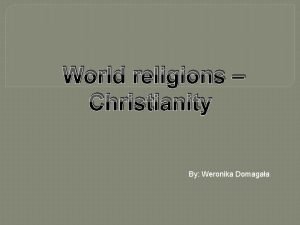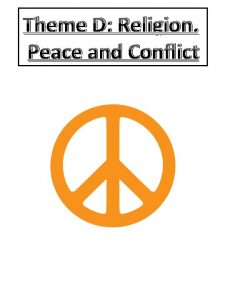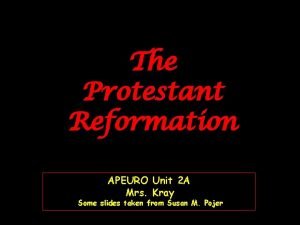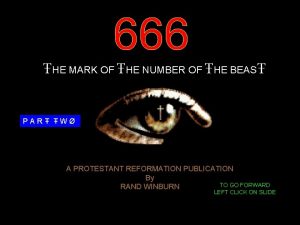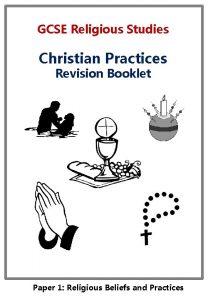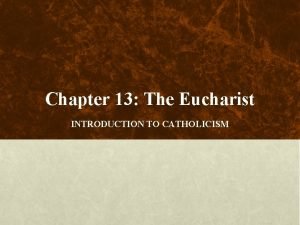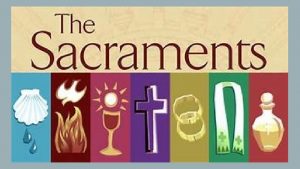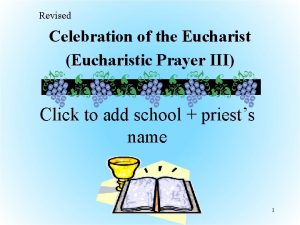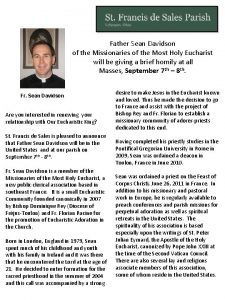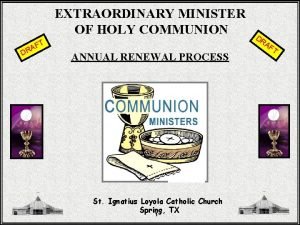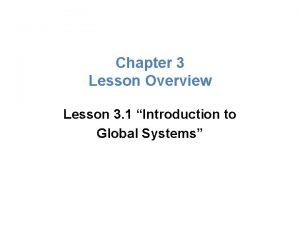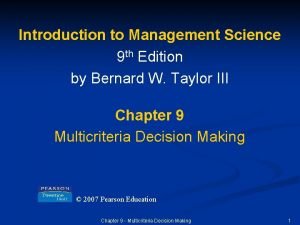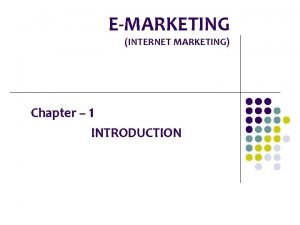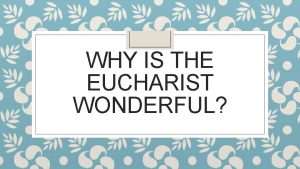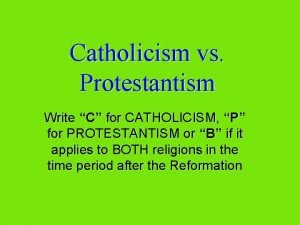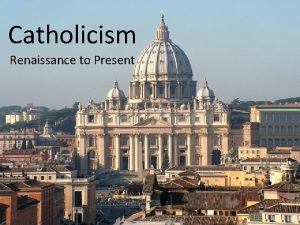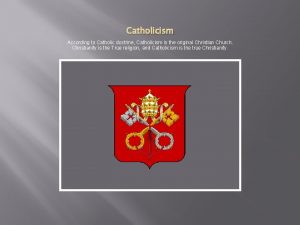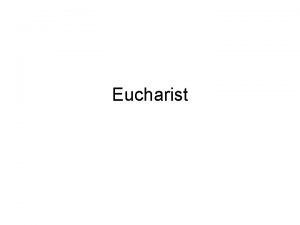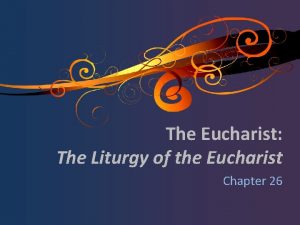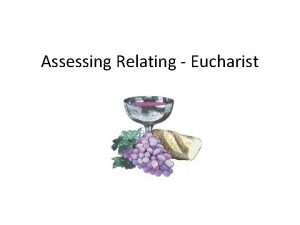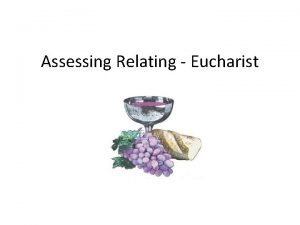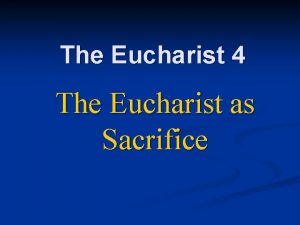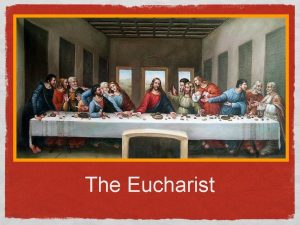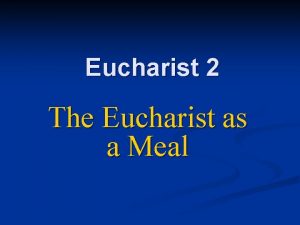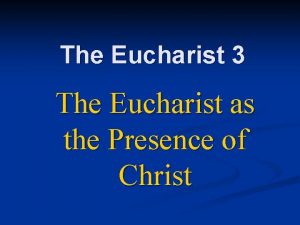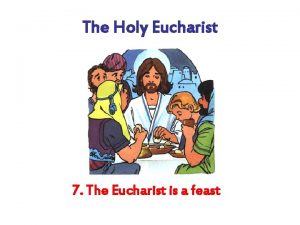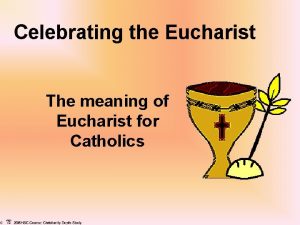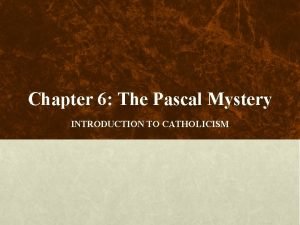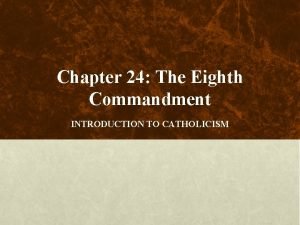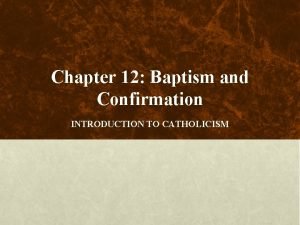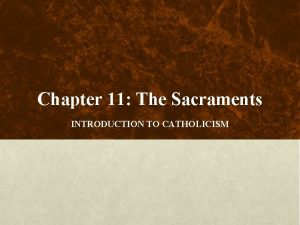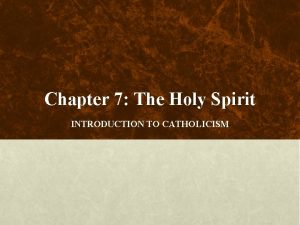Chapter 13 The Eucharist INTRODUCTION TO CATHOLICISM 1

































































- Slides: 65

Chapter 13: The Eucharist INTRODUCTION TO CATHOLICISM

1. The Real Presence (pp. 286 -292) ANTICIPATORY SET Read the Gospel of St. John, Chapter 6, together. Then discuss the following question: Was it reasonable for people to reject Christ’s teaching that he is the Bread of Life? Why or why not?

1. The Real Presence (pp. 286 -292) BASIC QUESTIONS What is the origin of the Eucharist? What is the Real Presence? KEY IDEAS Foreshadowed in the Old Testament and in the “bread of life” discourse in the Gospel of St. John, the Eucharist was instituted by Christ at the Last Supper. The Real Presence means that Christ’s Body, Blood, Soul, and Divinity become present under the appearances of bread and wine during the Consecration of the Mass.

1. The Real Presence (pp. 286 -292) FOCUS QUESTIONS What did Christ explain to the two disciples on the road to Emmaus? He explained how his Passion, Death, and Resurrection fulfilled what the prophets had foretold about the Messiah. When did the two disciples recognize their companion was the risen Christ? They recognized him “in the breaking of the bread. ” What does the road to Emmaus teach us about how we encounter Christ today? We find Christ in the breaking of the bread, that is, in the Holy Eucharist. Extension: The “breaking of the bread” was the term the early Church first used for the Liturgy of the Eucharist.

1. The Real Presence (pp. 286 -292) FOCUS QUESTIONS What is the origin of the word “eucharist”? It literally means thanksgiving (from the Greek eucharistein) and comes from the words of Scripture, “When he [Christ] had given thanks, ” (Lk 22: 19), which preceded the Consecration of bread and wine at the Last Supper. What are some of the Old Testament foreshadowings of the Eucharist? Old Testament types include the Passover meal, a sacrificial meal in which a spotless lamb was eaten as a memorial; the manna in the desert, in which God gave the Israelites bread from Heaven for their daily food;

1. The Real Presence (pp. 286 -292) FOCUS QUESTIONS When did Christ institute the Eucharist? He instituted the Eucharist at the Last Supper. Why did Christ institute the Eucharist? He instituted the Eucharist to pledge his love, to remain with his disciples forever, to memorialize his Death and Resurrection, and to create the Sacrifice of the New Covenant by which we could be participants in the Sacrifice of the Cross.

1. The Real Presence (pp. 286 -292) FOCUS QUESTIONS How did Christ identify himself with the manna that the Hebrews ate in the desert? Jesus Christ said he was the true bread that has come down from Heaven, an allusion to that former bread that had come down from heaven. According to Christ, what is the difference between the manna and the Bread of Life? The manna sustained natural life, but the Bread of Life will give eternal life. What is the connection between the Bread of Life and Christ’s Body? They are identical; Christ proclaimed, “‘The bread which I shall give for the life of the world is my flesh’” (Jn 6: 51).

1. The Real Presence (pp. 286 -292) FOCUS QUESTIONS What was the effect on his followers of Christ’s teaching about the Bread of Life? Many abandoned him, although the Twelve stayed with him even though they did not understand at the time. How do Christ’s words at the Last Supper, “This is my body, which is given for you, ” (Lk 22: 19) relate to the Cross? Christ gave his Body and shed his Blood on the Cross for the salvation of the world.

1. The Real Presence (pp. 286 -292) GUIDED EXERCISE Think/Pair/Share using the following question: How do we know that Christ was not speaking figuratively when he taught the crowds that they had to eat his Body and drink his Blood if they wanted eternal life?

1. The Real Presence (pp. 286 -292) FOCUS QUESTIONS What does it mean to say that Christ’s language at the Last Supper was “unequivocal”? Jesus’ use of the Greek verb “to be” (“This ‘is’ my body; this ‘is’ my blood”) is literal and not metaphorical, real and not figurative. What is the Church’s understanding of Christ’s words, “‘Do this in memory of me’” (Lk 22: 19)? Christ was giving his Apostles—and their successors, the bishops—the power to transform bread and wine into his Body and Blood. Where is this power exercised? This power is exercised in the Mass.

1. The Real Presence (pp. 286 -292) FOCUS QUESTIONS What happens to the bread and wine at the Consecration of the Mass? When the bishop or priest says the words of consecration over the bread and wine, the substance of the bread and wine is changed into the Body and Blood of Christ. This is accomplished by the power of the Holy Spirit acting through Jesus Christ. What do people perceive with their human senses after the Consecration? People still perceive ordinary bread and wine.

1. The Real Presence (pp. 286 -292) FOCUS QUESTIONS Where did the early Christians see Christ’s words about the Bread of Life and its necessity for salvation fulfilled? They saw them fulfilled in the Eucharist, established at the Last Supper, and in Christ’s Sacrifice on the Cross. According to the Catechism, no. 1470, how is the Eucharist the source and summit of the Catholic Faith? It is the source because by this sacrifice Christ “pours out the graces of salvation on…the Church. ” It is the summit because by this Sacrifice Christ associates the “Church and all her members with his sacrifice of praise and thanksgiving offered once for all on the cross to his Father. ” In other words, the Eucharist, being Christ himself, is both the source of each Christian’s faith and its highest expression because it is Christ’s supreme offering of himself to the Father.

1. The Real Presence (pp. 286 -292) FOCUS QUESTIONS What is known by faith? By faith, it is known that Christ is present beneath the appearances of the bread and wine. What does “Real Presence” mean? The Real Presence is the faith of the Church that Christ is really present in the Eucharist: Body, Blood, Soul, and Divinity.

1. The Real Presence (pp. 286 -292) FOCUS QUESTIONS What is the technical term for the transformation of the bread and wine into the Body and Blood of Christ? It is transubstantiation. How does St. Paul support the Real Presence of Christ in the Eucharist? He warned those who receive the Eucharist to do so worthily, by “discerning the body, ” that is, by recognizing Christ’s Real Presence, lest they “eat and drink judgment” (1 Cor 11: 29) upon themselves.

1. The Real Presence (pp. 286 -292) GRAPHIC ORGANIZER Complete the following table to summarize how the early Church understood the Eucharist.

1. The Real Presence (pp. 286 -292)

1. The Real Presence (pp. 286 -292) GUIDED EXERCISE Work with a partner to ask and answer three Focus Questions that illustrate three most important points in the sidebar, “Miracles of the Eucharist” (p. 291).

1. The Real Presence (pp. 286 -292) CLOSURE Write a paragraph on the origin of the Eucharist and the meaning of the Real Presence.

1. The Real Presence (pp. 286 -292) HOMEWORK ASSIGNMENT Study Questions 1 -6 (p. 310) Practical Exercises 1 -3 (p. 311) Workbook Questions 1 -11 Read “One Single Sacrifice” through the sidebar “Spiritual Communion” (pp. 292 -302)

1. The Real Presence (pp. 286 -292) ALTERNATIVE ASSESSMENT With a copy of John 6 in front of you, free write for five minutes on the connection between the manna in the desert and the Eucharist.

2. Celebration of the Eucharist (pp. 292 -302) ANTICIPATORY SET Incorporate the account of the Ascension of Christ (cf. Mt 28: 16 -20) into the Opening Prayer.

2. Celebration of the Eucharist (pp. 292 -302) BASIC QUESTIONS What is the connection between the Sacrifice of the Mass and the Sacrifice of the Cross? What are the requirements to receive the Eucharist worthily? What are the matter, form, and minister of the Eucharist? What is the proper way to receive Holy Communion? Why does the Church reserve Holy Communion outside Mass? What are the effects of a worthy reception of the Eucharist? KEY IDEAS The Sacrifice of the Mass and the Sacrifice of the Cross are one and the same sacrifice. To receive the Eucharist worthily, one must be a baptized Catholic in a state of grace, understand what one is about to receive, and have kept the Eucharistic fast. The matter of the Eucharist is wheat bread and grape wine; the form is the words “This is my body…This is the chalice of my blood”; and the minister is a validly ordained priest. Each Christian should receive the Eucharist devoutly in the manner the Church prescribes. The Church reserves consecrated hosts in the tabernacle so the Eucharist can be brought to the sick and that the faithful can adore the Blessed Sacrament outside of Mass. Some of the effects of a worthy reception of the Eucharist are intimate communion with Christ, deeper union with the Body of Christ, forgiveness of venial sins, and an increase in graces and virtues in the

2. Celebration of the Eucharist (pp. 292 -302) FOCUS QUESTIONS What is the formal name of the Mass? The Holy Sacrifice of the Mass. How are the Sacrifice of the Mass and the Sacrifice of the Cross but a single sacrifice? In the Mass, the one Sacrifice of Christ on Calvary is made present (i. e. , it is “re-presented”). What is the Sacrifice of Christ on Calvary? It is Christ’s self-offering of his life to the Father for the forgiveness of all people’s sins.

2. Celebration of the Eucharist (pp. 292 -302) FOCUS QUESTIONS What is the Sacrifice of the Mass according to the Catechism? The Mass is a sacrifice of praise, thanksgiving, propitiation in reparation for sin, and adoration. How do the multiple sacrifices of the Old Testament relate to the single Sacrifice of Christ and the many Masses the Church celebrates? Because the sacrifices offered in the Old Testament were imperfect, they had to be repeated time and again. Christ’s Sacrifice, however, is perfect, and thus it only needed to be offered once. The one Sacrifice of Christ is made present in a mystical way at every Mass.

2. Celebration of the Eucharist (pp. 292 -302) FOCUS QUESTIONS Why did the Apostles celebrate the Eucharist? They celebrated the Eucharist in obedience to Christ’s command, “‘Do this in remembrance of me’” (Lk 22: 19). What is the reality that is “memorialized” in the Mass? It is the resurrected Christ, who gives himself to his people sacramentally under the appearance of bread and wine.

2. Celebration of the Eucharist (pp. 292 -302) FOCUS QUESTION According to CCC 1363, what is the biblical meaning of remembrance? The biblical meaning of remembrance is not merely the recollection of past events but the proclamation of the mighty works wrought by God for his people, in which the events become in some way real and present. For example, every year when the Passover is celebrated, the Exodus events are made present to the memory of believers so that they may conform their lives to them.

2. Celebration of the Eucharist (pp. 292 -302) GUIDED EXERCISE Perform a focused reading of the Catechism, no. 1367, using the following question: How are the Sacrifice of Christ and the Sacrifice of the Eucharist “one single sacrifice”?

2. Celebration of the Eucharist (pp. 292 -302) FOCUS QUESTIONS In the Western Church, what Sacrament must one receive before receiving first Holy Communion? In the case of a person baptized as an infant, he or she must receive the Sacrament of Penance (Reconciliation) before First Holy Communion. What is the Communion fast? Except for grave reasons, one must fast from all food and drink except water or medicine for one hour before receiving Communion.

2. Celebration of the Eucharist (pp. 292 -302) FOCUS QUESTIONS What are the basic requirements for receiving the Eucharist? One must be a baptized Catholic in a state of grace (not aware of any mortal sins), understand what one is about to receive, and have kept the Communion fast. What are the matter, form, and minister of the Sacrament of the Eucharist? The matter is bread made from wheat flour and wine made from grapes. The form is the words of consecration: “This is my body…This is the chalice of my blood. ” The minister is a priest or bishop.

2. Celebration of the Eucharist (pp. 292 -302) FOCUS QUESTIONS Who are the ordinary ministers of the distribution of Holy Communion? They are bishops, priests, and deacons. Who can be extraordinary ministers of the distribution of Holy Communion? Religious and lay people can, under certain conditions, serve as extraordinary ministers of the distribution of Holy Communion.

2. Celebration of the Eucharist (pp. 292 -302) FOCUS QUESTIONS Why does the Church not allow separated brethren to receive Holy Communion? The Eucharist is a sign of communion, and those who receive it are manifesting their union in Christ. Sharing Communion with non. Catholic Christians would indicate a unity that in reality does not exist. May Catholics receive communion in non-Catholic ecclesial communities? No.

2. Celebration of the Eucharist (pp. 292 -302) GUIDED EXERCISE Work with a partner to explain the difference in the problem of intercommunion between (1) Catholics and Christians whose churches derive from the Reformation and (2) Catholics and Christians of the Eastern Orthodox Churches.

2. Celebration of the Eucharist (pp. 292 -302) FOCUS QUESTIONS What did the term “breaking of the bread” mean in the early Church? This term meant the celebration of the Eucharist. How did the primitive Church worship on two days? Jewish Christians in Jerusalem prayed and read the Scriptures in the Temple on Saturday and then met in their own homes for the breaking of the bread on Sunday, the day of the Resurrection.

2. Celebration of the Eucharist (pp. 292 -302) FOCUS QUESTIONS What parts of the Mass developed from this tradition of the primitive Church? The Liturgy of the Word and the Liturgy of the Eucharist developed from this tradition. When did these two parts come together on one day? The two liturgies were combined into a single act of worship on Sunday after the Jewish Christians were expelled from the Jewish synagogues, a place the Gentile Christians never could enter.

2. Celebration of the Eucharist (pp. 292 -302) FOCUS QUESTIONS How do Catholics make an annual tour of Christ’s life in the Mass? Readings from the Gospels and the Acts of the Apostles at Mass lead believers through the life of Christ, beginning with his Incarnation and Birth and ending with his Resurrection, Pentecost, and the life of the early Church. What do the other readings at Mass do? By presenting the Old Testament alongside the New, the readings for the Mass help make connections within the Bible that reveal God’s intention for the world.

2. Celebration of the Eucharist (pp. 292 -302) FOCUS QUESTIONS What is a great way to become familiar with the Sacred Scriptures? Attend Mass daily and listen attentively to and think about the readings. What is the liturgical year? The liturgical year is the annual cycle that, in the Western Catholic Church, begins with Advent and ends with the feast of Christ the King. Extension: The liturgical year in the Eastern Catholic Churches begins just before the Nativity of the Blessed Virgin Mary on September 8, and ends shortly after her Dormition on August 15.

2. Celebration of the Eucharist (pp. 292 -302) GUIDED EXERCISE Sum up the liturgical year in one sentence, taking into account all the major events.

2. Celebration of the Eucharist (pp. 292 -302) FOCUS QUESTIONS What is at the heart of the Liturgy of the Eucharist? The words of Consecration and the reception of Holy Communion are at its heart. How is the Concluding Rite of the Mass actually a beginning? The Concluding Rite directs the faithful to bring Christ into the midst of the world, to serve others, and to inspire them to faith in Christ. What is at the heart of the Liturgy of the Word? The Sacred Scripture readings are at its heart.

2. Celebration of the Eucharist (pp. 292 -302) FOCUS QUESTIONS How many rites of worship are there in the Catholic Church? There about twenty Eastern Rites of the Catholic Church and one Latin Rite. What is the Catholic Rite with which most Catholics are familiar? Most are familiar with the Latin Rite.

2. Celebration of the Eucharist (pp. 292 -302) FOCUS QUESTIONS What is the origin of most of the Eastern Rites of the Catholic Church? These rites arose centuries ago in Catholic Churches in the eastern part of the Roman Empire, which have retained their traditional liturgies and pastoral traditions. Can Catholics receive the Sacraments in either the Eastern and Latin Rite? Yes; both the Eastern and Latin Rites are all fully Catholic.

2. Celebration of the Eucharist (pp. 292 -302) FOCUS QUESTIONS How does one receive Communion in the extraordinary form of the Latin Rite? In the extraordinary form of the Latin Rite, one receives Communion on the tongue, kneeling at the altar rail. How is Communion usually received in the Eastern Rites of the Catholic Church? In the Eastern Rites of the Catholic Church, one usually receives Communion by intinction, that is, the consecrated hosts (the Body of Christ), which are leavened in most Rites, are dipped or soaked with the consecrated wine (the Blood of Christ).

2. Celebration of the Eucharist (pp. 292 -302) FOCUS QUESTIONS What is the Rite of Holy Communion? It is the reception of the Body and Blood of Christ either within or outside of Mass. What does one receive if given a tiny, broken piece of a host (Communion wafer)? One receives Jesus Christ, whole and entire—Body, Blood, Soul, and Divinity.

2. Celebration of the Eucharist (pp. 292 -302) FOCUS QUESTIONS What are the two ways the host (Communion wafer) is received? The normal manner is on the tongue. When permitted by the national council of bishops in a particular country, it can be received in the hand. What should one do before receiving Communion if not kneeling? One should bow or show some other form of reverence before the Presence of Christ.

2. Celebration of the Eucharist (pp. 292 -302) FOCUS QUESTIONS What precedes the Communion Rite? The Communion Rite is preceded by the Agnus Dei (“Lamb of God”), which asks mercy and peace from the “Lamb of God, who takes away the sins of the world. ” Why does the Church encourage frequent Communion? In Communion the faithful receive Christ himself.

2. Celebration of the Eucharist (pp. 292 -302) FOCUS QUESTIONS What is reserved in the tabernacle in a Catholic Church? Consecrated Hosts that have not been consumed during Holy Communion are reserved. Why are they reserved? They are used to offer Holy Communion to the sick and homebound, for the distribution of Communion outside the Mass or when insufficient number of hosts have been consecrated during a Mass, and so the faithful can visit the church for prayer and worship in the presence of the Blessed Sacrament. When does the Eucharistic presence begin and end? It begins at the moment of the Consecration and endures as long as the Eucharistic species subsist. They cease to subsist when they lose their appearance of bread or wine, for example, in the digestive process.

2. Celebration of the Eucharist (pp. 292 -302) GUIDED EXERCISE Work with a partner to make a bullet-point summary of the effects of receiving Holy Communion.

2. Celebration of the Eucharist (pp. 292 -302) FOCUS QUESTIONS What is a Spiritual Communion? It is a form of prayer in which a person asks Christ to make himself present in his or her soul in a spiritual manner when he or she cannot receive him physically in the Eucharist. How often can a person make a spiritual communion? This can be done as often as one wishes.

2. Celebration of the Eucharist (pp. 292 -302) CLOSURE Answer the Basic Questions of this lesson in one or two sentences.

2. Celebration of the Eucharist (pp. 292 -302) HOMEWORK ASSIGNMENT Study Questions 7 -21 (p. 310) Practical Exercises 4 -6 (p. 311) Workbook Questions 12 -27 Read “Transformed by the Mass” through “Conclusion” (pp. 303306)

2. Celebration of the Eucharist (pp. 292 -302) ALTERNATIVE ASSESSMENT Work with a partner to develop an apologetics for the Eucharist as the Real Presence of the Body and Blood of Christ.

3. Giving the Eucharist Our Best (pp. 303 -306) ANTICIPATORY SET Make a visit to the Blessed Sacrament. Enter quietly, genuflect before the tabernacle, say simple vocal prayers like an Our Father, a Hail Mary, and a Glory Be, and then perhaps make a spiritual communion before genuflecting as you silently leave.

3. Giving the Eucharist Our Best (pp. 303 -306) BASIC QUESTIONS How does a person give his or her best at Mass? How do Catholics adore Christ outside Mass? KEY IDEAS The Church calls the faithful to a fully conscious and active participation in the Mass, attendance at which is obligatory for Catholics show their devotion to the Real Presence of Christ through Eucharistic adoration.

3. Giving the Eucharist Our Best (pp. 303 -306) GUIDED EXERCISE Complete a paragraph shrink on the paragraph “Although the liturgy may be…” (p. 303).

3. Giving the Eucharist Our Best (pp. 303 -306) FOCUS QUESTIONS What is the effect of participation in the Holy Mass? People receive grace and are transformed through the Holy Mass. How are people supposed to participate in the Holy Mass? The Church calls the faithful to “fully conscious, and active participation” in the Mass.

3. Giving the Eucharist Our Best (pp. 303 -306) FOCUS QUESTIONS What is the Sunday obligation? Catholics are required to attend Mass every Sunday and Holy Day of Obligation. Is it a sin to miss Sunday Mass without a serious reason? Yes; it is a serious sin. Why can the Mass be celebrated in almost any dignified place? The Mass can be celebrated in almost any dignified place because all the earth is holy and has been entrusted to human beings.

3. Giving the Eucharist Our Best (pp. 303 -306) GUIDED EXERCISE Complete the following table to summarize how to participate more completely in the Mass.

3. Giving the Eucharist Our Best (pp. 303 -306)

3. Giving the Eucharist Our Best (pp. 303 -306) FOCUS QUESTIONS How does the Mass fulfill Christ’s promise that he would be with us until the end of time? Christ is truly present in the Eucharist. Why did the early Church reserve the Eucharist? It could be brought to the sick or those who could not attend Mass for some other good reason.

3. Giving the Eucharist Our Best (pp. 303 -306) FOCUS QUESTIONS What factor led to Eucharistic devotions outside Mass? The understanding of the Real Presence of Christ in the Eucharist led to Eucharistic devotions outside of Mass. What is a visit to the Blessed Sacrament? It is visiting a church and spending some time in silent prayer before the Eucharist in the tabernacle.

3. Giving the Eucharist Our Best (pp. 303 -306) FOCUS QUESTIONS What is a ciborium? It is the covered cup in which consecrated hosts are reserved in the tabernacle. What is a monstrance? It is an ornate receptacle in which the Eucharist is exposed for adoration. What is perpetual adoration? It is the devotion in which some worshipers are always present in front of the Blessed Sacrament.

3. Giving the Eucharist Our Best (pp. 303 -306) FOCUS QUESTIONS What is a spiritual communion? It is a pious act whereby a person expresses in prayer his or her desire to receive the Eucharist when he or she cannot due to its unavailability or lacking a state of grace. What is the most common time that Eucharistic processions take place? Eucharistic processions most commonly take place on the Feast of Corpus Christi.

3. Giving the Eucharist Our Best (pp. 303 -306) CLOSURE Write a paragraph summarizing how you can give your best to the Mass.

3. Giving the Eucharist Our Best (pp. 303 -306) HOMEWORK ASSIGNMENT Study Questions 22 -24 (p. 310) Practical Exercise 7 (p. 311) Workbook Questions 28 -37

3. Giving the Eucharist Our Best (pp. 303 -306) ALTERNATIVE ASSESSMENT Free write confidentially on what is the greatest obstacle to your full participation in the Mass and what you might do to improve this participation.

The End
 The sacrament of the eucharist chapter 5
The sacrament of the eucharist chapter 5 The sacrament of the eucharist chapter 5
The sacrament of the eucharist chapter 5 Branches of catholicism
Branches of catholicism Branches of catholic church
Branches of catholic church Amish catholic
Amish catholic Who was the greatest supporter of militant catholicism
Who was the greatest supporter of militant catholicism Christianity vs catholicism
Christianity vs catholicism Catholic vs christian
Catholic vs christian Protestant vs catholic
Protestant vs catholic Catholic beliefs
Catholic beliefs Christianity beliefs and practices
Christianity beliefs and practices What is a eucharist
What is a eucharist Holy orders form
Holy orders form Eucharistic prayer
Eucharistic prayer Penitential rite prayer
Penitential rite prayer Father sean davidson
Father sean davidson Eucharist multiple choice questions
Eucharist multiple choice questions The sacred vessels
The sacred vessels Hình ảnh bộ gõ cơ thể búng tay
Hình ảnh bộ gõ cơ thể búng tay Frameset trong html5
Frameset trong html5 Bổ thể
Bổ thể Tỉ lệ cơ thể trẻ em
Tỉ lệ cơ thể trẻ em Voi kéo gỗ như thế nào
Voi kéo gỗ như thế nào Glasgow thang điểm
Glasgow thang điểm Bài hát chúa yêu trần thế alleluia
Bài hát chúa yêu trần thế alleluia Môn thể thao bắt đầu bằng từ chạy
Môn thể thao bắt đầu bằng từ chạy Thế nào là hệ số cao nhất
Thế nào là hệ số cao nhất Các châu lục và đại dương trên thế giới
Các châu lục và đại dương trên thế giới Công thức tiính động năng
Công thức tiính động năng Trời xanh đây là của chúng ta thể thơ
Trời xanh đây là của chúng ta thể thơ Mật thư tọa độ 5x5
Mật thư tọa độ 5x5 101012 bằng
101012 bằng Phản ứng thế ankan
Phản ứng thế ankan Các châu lục và đại dương trên thế giới
Các châu lục và đại dương trên thế giới Thơ thất ngôn tứ tuyệt đường luật
Thơ thất ngôn tứ tuyệt đường luật Quá trình desamine hóa có thể tạo ra
Quá trình desamine hóa có thể tạo ra Một số thể thơ truyền thống
Một số thể thơ truyền thống Cái miệng xinh xinh thế chỉ nói điều hay thôi
Cái miệng xinh xinh thế chỉ nói điều hay thôi Vẽ hình chiếu vuông góc của vật thể sau
Vẽ hình chiếu vuông góc của vật thể sau Biện pháp chống mỏi cơ
Biện pháp chống mỏi cơ đặc điểm cơ thể của người tối cổ
đặc điểm cơ thể của người tối cổ Ví dụ về giọng cùng tên
Ví dụ về giọng cùng tên Vẽ hình chiếu đứng bằng cạnh của vật thể
Vẽ hình chiếu đứng bằng cạnh của vật thể Phối cảnh
Phối cảnh Thẻ vin
Thẻ vin đại từ thay thế
đại từ thay thế điện thế nghỉ
điện thế nghỉ Tư thế ngồi viết
Tư thế ngồi viết Diễn thế sinh thái là
Diễn thế sinh thái là Dạng đột biến một nhiễm là
Dạng đột biến một nhiễm là Các số nguyên tố là gì
Các số nguyên tố là gì Tư thế ngồi viết
Tư thế ngồi viết Lời thề hippocrates
Lời thề hippocrates Thiếu nhi thế giới liên hoan
Thiếu nhi thế giới liên hoan ưu thế lai là gì
ưu thế lai là gì Hổ đẻ mỗi lứa mấy con
Hổ đẻ mỗi lứa mấy con Khi nào hổ mẹ dạy hổ con săn mồi
Khi nào hổ mẹ dạy hổ con săn mồi Hệ hô hấp
Hệ hô hấp Từ ngữ thể hiện lòng nhân hậu
Từ ngữ thể hiện lòng nhân hậu Thế nào là mạng điện lắp đặt kiểu nổi
Thế nào là mạng điện lắp đặt kiểu nổi Essay structure introduction
Essay structure introduction Chapter 3 lesson 1 introduction to global systems
Chapter 3 lesson 1 introduction to global systems Role of operations management
Role of operations management Introduction to management science chapter 5 solutions
Introduction to management science chapter 5 solutions Chapter 52: an introduction to ecology and the biosphere
Chapter 52: an introduction to ecology and the biosphere Internet e marketing
Internet e marketing


